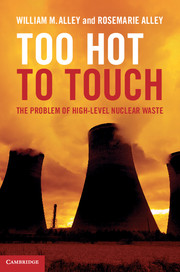22 - Nuclear waste and our energy future
from Part III - No solution in sight
Published online by Cambridge University Press: 05 February 2013
Summary
We have conquered Mother Nature;
now we have only to conquer human nature.
D. R. KnowltonImagine that starting tomorrow the world permanently shutters all of its nuclear reactors – in power plants, submarines, aircraft carriers, universities, and medical research laboratories. Even in such an event, massive amounts of spent nuclear fuel, high-level reprocessing wastes, and excess plutonium from dismantled nuclear warheads would still be with us. This huge backlog of wastes remains, whether or not we ever produce another kilowatt of electricity from a nuclear power plant. Regardless of one's stance on nuclear energy, everyone has a stake in finding a long-term solution for the waste.
Adding urgency to solving the waste problem is that nuclear energy is one of the proposed solutions for addressing global warming. In a widely cited article in 2004, Stephen Pacala and Robert Socolow of Princeton University argued that humanity can solve the climate problem by scaling up what we already know how to do. Although technically feasible, the magnitude of this scale-up is monumental. Meeting the world’s projected energy needs over the next 50 years, while also stabilizing atmospheric carbon dioxide (CO2), would require the equivalent of all the following actions: (1) increase fuel economy for 2 billion cars from 30 to 60 miles per gallon, (2) cut carbon emissions by one-fourth in buildings and appliances, (3) replace 1,400 GW (gigawatts) of coal plants with natural gas plants amounting to four times the current production of gas-based power, (4) capture and store 80 percent of the CO2 from today’s coal energy production, (5) increase biofuels production to a level that would require one-sixth of the world’s cropland, (6) install 2 million 1-megawatt wind turbines that would occupy an area equal to three percent of the United States (some on land and some offshore) and, finally, (7) replace 700 GW of coal-based power generation with nuclear energy, an increase equal to about twice the current worldwide nuclear capacity.
- Type
- Chapter
- Information
- Too Hot to TouchThe Problem of High-Level Nuclear Waste, pp. 321 - 329Publisher: Cambridge University PressPrint publication year: 2012



